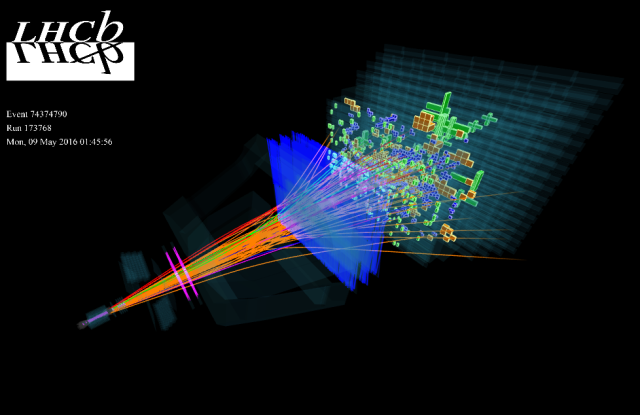New particles discovered in CERN experiment with Warwick physicist
A new group of particles which have long been hiding in plain sight have finally been discovered thanks to the incredibly sensitive LHCb experiment at CERN - involving a physicist from the University of Warwick.
Professor Tim Gershon from the Department of Physics is the UK spokesperson for the LHCb, otherwise known as the Large Hadron Collider beauty experiment.
The LHCb experiment is one of seven experiments collecting data at the Large Hadron Collider at CERN.
In a new paper, the LHCb collaboration has announced an exceptional and unique observation of five new baryons, particles composed of three quarks.
These new baryons are high-energy excited states of the Omega_c baryon, a particle made of two ‘strange’ and one ‘charm’ quark.
Quarks are one of the fundamental building blocks for matter, combining to make hadrons. There are six types of quark – ‘up’, ‘down’, ‘strange’, ‘charm’, ‘top’ and ‘bottom’.
LHCb scientists reconstructed the short-lived Omega-c baryon from its decay to a Xi baryon, a particle containing a ‘charm’, a ‘strange’ and an ‘up’ quark, and a kaon K-, a particle made up of a ‘strange’ quark and an ‘up’ antiquark.
The Xi baryon then decayed further into a proton, a kaon K-, and a pion.
By studying the trajectories and energies deposited by all the particles, LHCb scientists uncovered the Omega_c baryon. They found not one, but five distinct new excited Omega_c baryon states.
Using the vast amounts of data collected during the operational life of the Large Hadron Collider, and the fantastic precision of LHCb’s detectors, scientists have been able to confirm the discovery is not just a fluke.
Physicists will now determine the precise properties of these new particles, which will contribute to our understanding of how quarks are bound inside a baryon using the strong nuclear force, otherwise known as ‘the strong interaction’.
Professor Tim Gershon explained what will come next for the LHCb experiment:
“After the LHCb experiment is upgraded in the next long shutdown of the LHC (during 2019-20), it will be able to move to the next stage in the search for new particles: namely, doubly heavy baryons.
“These states – which contain two charm quarks or two beauty quarks or one of each – have long been predicted, but never yet observed. Their discovery will help to address important unsolved questions about how hadrons are bound together by the strong interaction.”
Tara Shears, Professor of Physics at University of Liverpool, is Liverpool’s LHCb group lead. She explains why this discovery is significant:
"These particles have been hiding in plain sight for years, but it's taken the exquisite sensitivity of LHCb's particle detectors to bring them to our attention.”
Professor Shears explained how the UK’s future involvement will be vital:
“We need the precision trajectory information from the VELO detector to reconstruct the trail of particles these new baryons produce, and information from the RICH detectors to know what these particles are - both detectors that the UK helped build.
“If we're uncovering these new particles now, who knows what else is in our data waiting to be discovered?"
UK participation in the experiment is funded by the Science and Technology Facilities Council.
Notes to editors:
The University of Warwick is one of the top 10 research environments in the UK for Physics, as assessed by REF 2014, with all aspects considered to be either world-leading or internationally excellent. 96% of the research papers submitted to REF2014 were judged to be at least "internationally excellent" and a quarter "world leading" (4*).
LHCb is one of the four main experiments at the Large Hadron Collider at CERN. LHCb was built in a cavern 100m below ground near Ferney-Voltaire in France. It is investigating the subtle differences between matter and antimatter in a bid to answer one of the most fundamental questions – why is our Universe made of matter?
UK participation in LHCb is funded by STFC, with contributions from the participating institutes, the Royal Society and European Union.
The UK participation in the international LHCb experiment is from eleven institutes. University of Birmingham, University of Bristol, University of Cambridge, University of Edinburgh, University of Glasgow, Imperial College London, University of Liverpool, University of Manchester, University of Oxford, STFC Rutherford Appleton Laboratory, University of Warwick.
21 March 2017
Further information, contact:
Luke Walton, International Press Officer
+44 (0) 7824 540 863
+44 (0) 2476 150 868
L dot Walton dot 1 at warwick dot ac dot uk

